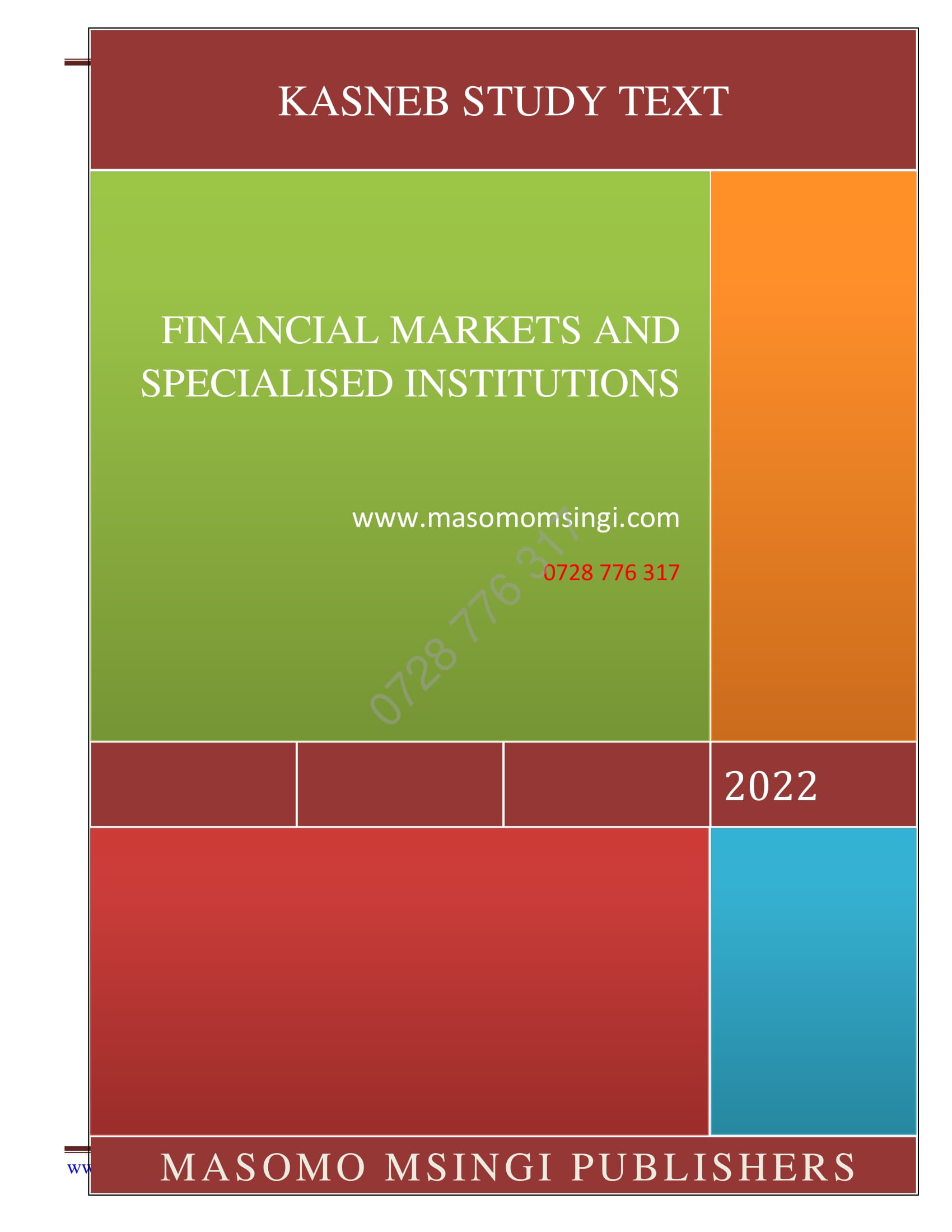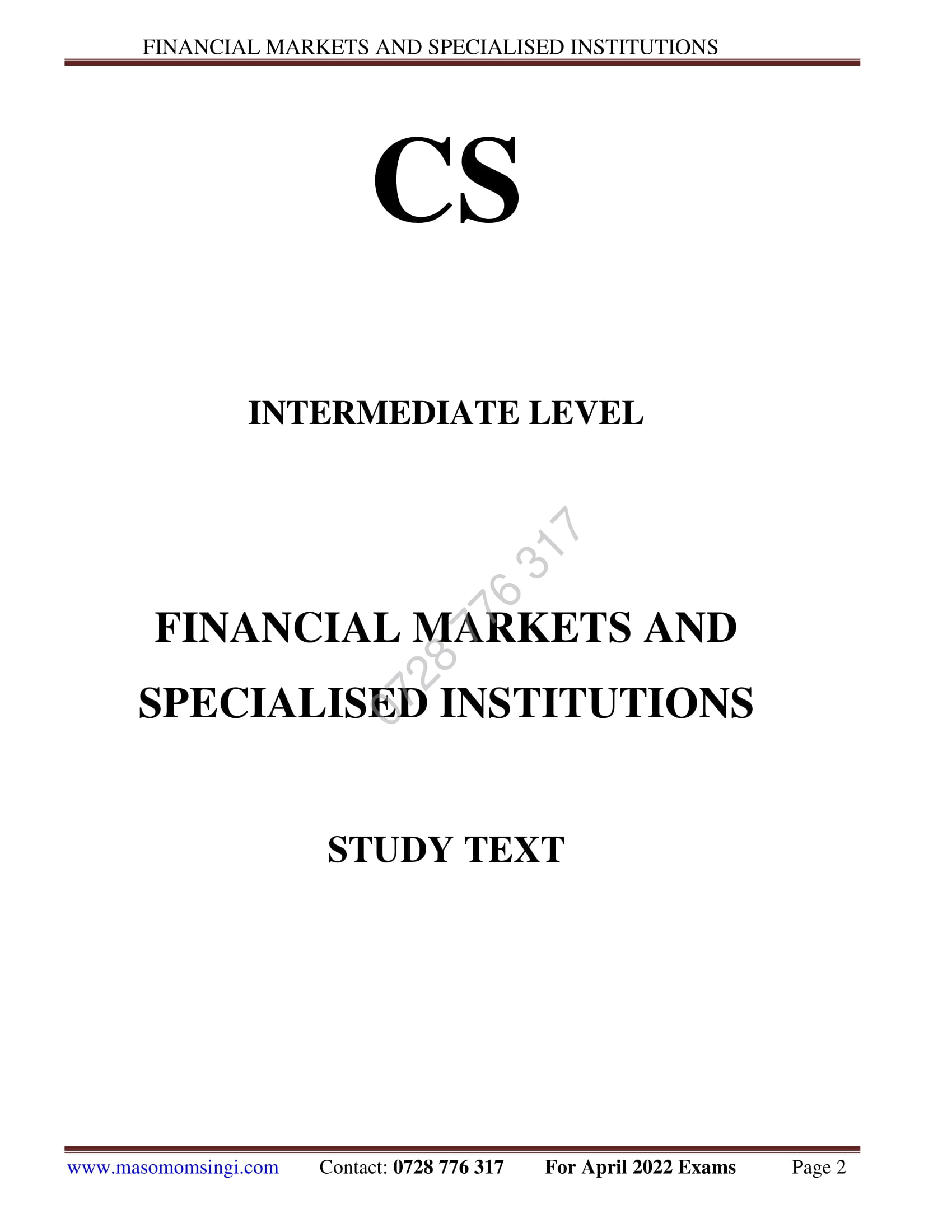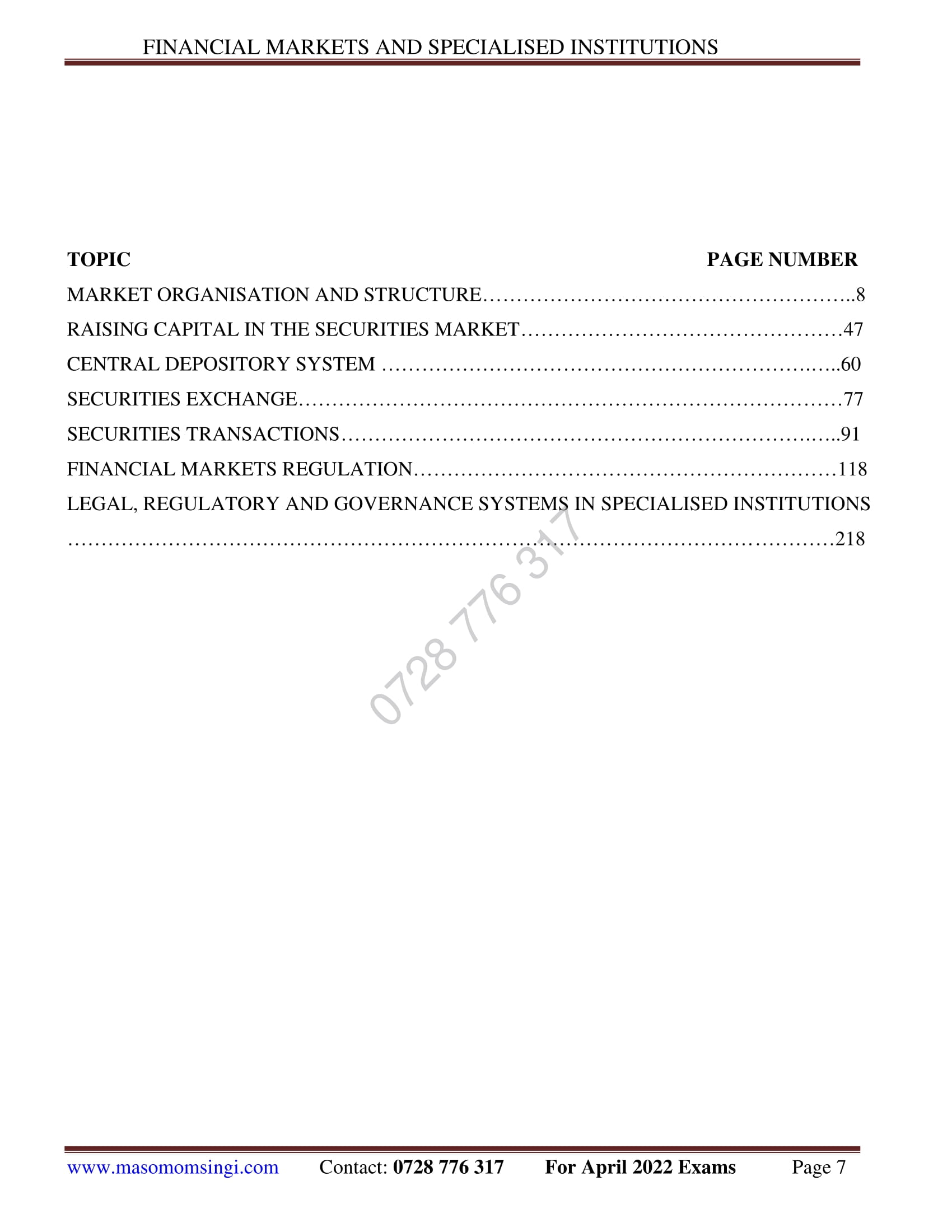MASOMO MSINGI PUBLISHERS APP – Click to download and access all our materials in soft copies
SAMPLE WORK
Complete copy of CS FINANCIAL MARKETS AND SPECIALISED INSTITUTIONS is available in SOFT copy (Reading using our MASOMO MSINGI PUBLISHERS APP) and in HARD copy
Phone: 0728 776 317
Email: info@masomomsingi.com



SAMPLE WORK
Complete copy of CS FINANCIAL MARKETS AND SPECIALISED INSTITUTIONS is available in SOFT copy (Reading using our MASOMO MSINGI PUBLISHERS APP) and in HARD copy
Phone: 0728 776 317
Email: info@masomomsingi.com
PAPER NO. 10: FINANCIAL MARKETS AND SPECIALISED INSTITUTIONS
UNIT DESCRIPTION
This paper is intended to equip the candidate with the knowledge, skills and attitudes that will enable him/her to apply governance and regulatory requirements in relation to financial market transactions.
LEARNING OUTCOMES
A candidate who passes this paper should be able to:
- Identify financial institutions and markets
- Advise on financial market regulations
- Trade in financial securities
- Explain the roles and functions of the financial sector in the economy
- Describe the emerging issues and trends in the financial markets
- Explain governance systems in specialised institutions
CONTENT
- Market organisation and structure
- Functions of financial markets
- Classifications of financial assets and markets
- Structure of financial markets
- Players within the financial services industry: central banks, retail banks, corporate banks; investment banks; retirement schemes; insurance companies; Saccos, fund managers; securities exchanges, stockbrokers; online foreign exchange brokers, insurance brokers, investment advisors, custodians; REIT managers and trustees, pension administrators; industry associations; professional bodies; crowdfunding; collective investment schemes (CIS); credit rating agencies
- Major types and characteristics of securities traded in organised markets: Equities, government bonds and bills, corporate bonds, currencies, derivative contracts and commodities.
- Flow of funds and financial systems
- Characteristics of a well-functioning financial system
- Automation of security exchanges: Automated trading systems (ATS)
- Raising capital in the securities market
- Types of shares
- Private offers
- Public offers; listing by introduction, offer by tender and rights issue
- Prospectus/information memorandum
- The International Organisation of Securities Commissions (IOSCO) principles for issuers
- Central Depository System
- The Central Depository Settlement Corporation
- Establishment of the central depository
- Duties of a central depository
- Central depository agents
- Rules and regulations of the central depository
- Remedies for breach of duties
- Security measures in the system
- Central Depository Guarantee Fund
- Immobilisation and dematerialisation of securities
- Securities Exchange
- Establishment, membership and roles of the security exchange
- Listing and post listing requirements
- Restriction of trade in eligible securities exchange
- Self-listing of the exchange
- Cross border listing
- Securities transactions
- Book entry of transactions and prohibition
- Records of depositors
- Suspended securities
- Suspension and delisting of securities
- Charging or mortgaging of securities
- Bonus and rights issues
- Prohibition of dealings in book entry securities
- Insider trading
- The International Organisation of Securities Commissions(IOSCO) principles for enforcement of securities regulation
- Financial markets regulation
- Historical development of the law and regulations governing financial markets
- The need for regulation and authorisation of firms
- Asymmetric information and financial regulation: government safety net, restrictions on asset holdings, capital and governance requirements.
- Role of government in the financial system; Capital Markets Authority (CMA), Central Bank of Kenya, Retirement Benefits Authority, Insurance Regulatory Authority, The Sacco Societies Regulatory Authority (SASRA), the Unclaimed Financial Assets Authority, Kenya Deposit Insurance Corporation (KDIC) and the Financial Reporting Centre
- Regulation of financial market intermediaries: Stockbrokers, Stock dealers, Investment banks, Investment advisers, Fund managers, Credit rating agencies, Collective investments schemes, Custodians, The International Organisation of Securities Commissions (IOSCO) principles for credit rating agencies, collective investment schemes and market intermediaries, Central Depository and Settlement Corporation (CDSC)
- Main aims and activities of financial services regulators
- Anti-money laundering and prevention of terrorism financing
- Functions and powers
- Due diligence requirements
- Corporate governance and conduct of business requirements
- Financial supervision: chartering and examination, assessment of risk
- Regulations in the international financial markets
- The International Organisation of Securities Commissions(IOSCO) principles for self-regulation
- Management, disclosure requirements, restrictions on competition
- Financial liberalisation, stratification and rationalisation
- Financial inclusion and deepening
- Bank runs and panics
- The liquidity crisis
- Legal, Regulatory and Governance systems in Specialised Institutions
- Pension Schemes
- Trusts and Foundations
- Clubs
- Religious organisations
- Educational institutions
- Co-operative societies
- Non governmental Organisations

SAMPLE WORK
Complete copy of CS FINANCIAL MARKETS AND SPECIALISED INSTITUTIONS is available in SOFT copy (Reading using our MASOMO MSINGI PUBLISHERS APP) and in HARD copy
Phone: 0728 776 317
Email: info@masomomsingi.com
CHAPTER ONE
MARKET ORGANISATION AND STRUCTURE
Functions of financial markets
Financial markets, from the name itself, are a type of marketplace that provides an avenue for the sale and purchase of assets such as bonds, stocks, foreign exchange, and derivatives. Often, they are called by different names, including “Wall Street” and “capital market,” but all of them still mean one and the same thing. Simply put, businesses and investors can go to financial markets to raise money to grow their business and to make more money, respectively.
- Price Determination
The financial market performs the function of price discovery of the different financial instruments which are traded between the buyers and the sellers on the financial market. The prices at which the financial instruments trade in the financial market are determined by the market forces i.e., demand and supply in the market.
So the financial market provides the vehicle by which the prices are set for both financial assets which are issued newly and for the existing stock of the financial assets.
- Funds Mobilization
Along with the determination of the prices at which the financial instruments trade in the financial market, the required return out of the funds invested by the investor is also determined by participants in the financial market. The motivation for persons seeking the funds is dependent on the required rate of return which is demanded by the investors.
Because of this function of the financial market only, it is signaled that how funds which available from the lenders or the investors of the funds will get allocated among the persons who are in need of the funds or raise the funds through the means of issuing financial instruments in the financial market. So, the financial market helps in the mobilization of the savings of the investors.
- Liquidity
The liquidity function of the financial market provides an opportunity for the investors to sell their financial instruments at its fair value prevailing in the market at any time during the working hours of the market.
In case there is no liquidity function of the financial market, then the investor forcefully have to hold the financial securities or the financial instrument until the conditions arise in the market to sell those assets or the issuer of the security is obligated contractually to pay for the same i.e., at the time of maturity in debt instrument or at the time of the liquidation of the company in case of the equity instrument is until the company is either voluntarily or involuntarily liquidated.
Thus, in the financial market investors can sell their securities readily and convert them into cash thereby providing the liquidity.
- Risk sharing
Financial market performs the function of the risk-sharing as the person who is undertaking the investments are different from the persons who are investing their fund in those investments.
With the help of the financial market, the risk is transferred from the person who undertakes the investments to those persons who provide the funds for making those investments.
- Easy Access
The industries require the investors for raising the funds and the investors require the industries for investing its money and earning the returns from them. So the financial market platform provides the potential buyer and seller easily, which helps them in saving their time and money in finding the potential buyer and seller.
- Reduction in Transaction Costs and Provision of the Information
The trader requires various types of information while doing the transaction of buying and selling the securities. For obtaining the same time and money is required.
But the financial market helps in providing every type of information to the traders without the requirement of spending any money by them. In this way, the financial market reduces the cost of the transactions.
- Capital Formation
Financial markets provide the channel through which the new savings of the investors flow in the country which aid in the capital formation of the country.
Types of Financial Markets
There are so many financial markets, and every country is home to at least one, although they vary in size. Some are small while some others are internationally known, such as the New York Stock Exchange (NYSE) that trades trillions of dollars on a daily basis.
Here are some types of financial markets.
- Stock market
The stock market trades shares of ownership of public companies. Each share comes with a price, and investors make money with the stocks when they perform well in the market. It is easy to buy stocks. The real challenge is in choosing the right stocks that will earn money for the investor.
There are various indices that investors can use to monitor how the stock market is doing, such as the Dow Jones Industrial Average (DJIA) and the S&P 500. When stocks are bought at a cheaper price and are sold at a higher price, the investor earns from the sale.
- Bond market
The bond market offers opportunities for companies and the government to secure money to finance a project or investment. In a bond market, investors buy bonds from a company, and the company returns the amount of the bonds within an agreed period, plus interest.
- Commodities market
The commodities market is where traders and investors buy and sell natural resources or commodities such as corn, oil, meat, and gold. A specific market is created for such resources because their price is unpredictable. There is a commodities futures market wherein the price of items that are to be delivered at a given future time is already identified and sealed today.
- Derivatives market
Such a market involves derivatives or contracts whose value is based on the market value of the asset being traded. The futures mentioned above in the commodities market is an example of a derivative.
Functions of the Markets
The role of financial markets in the success and strength of an economy cannot be underestimated. Here are four important functions of financial markets:
- Puts savings into more productive use
As mentioned in the example above, a savings account that has money in it should not just let that money sit in the vault. Thus, financial markets like banks open it up to individuals and companies that need a home loan, student loan, or business loan.
- Determines the price of securities
Investors aim to make profits from their securities. However, unlike goods and services whose price is determined by the law of supply and demand, prices of securities are determined by financial markets.
- Makes financial assets liquid
Buyers and sellers can decide to trade their securities anytime. They can use financial markets to sell their securities or make investments as they desire.
- Lowers the cost of transactions
In financial markets, various types of information regarding securities can be acquired without the need to spend.
Financial market provides complete information regarding price, availability and cost of various financial securities. So, investors and companies do not have to spend much on getting this information as it is readily available in financial markets.
- Facilitate Price Discovery:
Price of anything depends upon the demand and supply factors. Demand and supply of financial assets and securities in financial markets help in deciding the prices of various financial securities.
Importance of Financial Markets
There are many things that financial markets make possible, including the following:
- Financial markets provide a place where participants like investors and debtors, regardless of their size, will receive fair and proper treatment.
- They provide individuals, companies, and government organizations with access to capital
- Financial markets help lower the unemployment rate because of the many job opportunities it offers
Classifications of financial assets and markets
Financial assets (investments) are commonly categorized into securities, currencies, contracts, commodities, and real assets.
Securities
Securities include equity securities, fixed-income securities, and pooled investments.
Equity securities
Equity securities represent an ownership interest in a company. These are either public (when listed on an exchange) or private (when not listed, such as private equity, venture capital). Major categories include common stock, preferred stock and warrants.
- Common stock: residual (left-over) interest in a company
- Preferred stock: preferred stake in assets and dividends
- Cumulative preferred stock: dividends accumulate when not paid
- Noncumulative preferred stock: dividends not paid do not accumulate
- Warrants: represents an option to buy equity
Fixed-income securities
Fixed income (also called debt investments) pay periodic interest and principal, which is either fixed, floating or indexed. These include:
- Bills (issued in money markets, typically issued by governments)
- Notes (issued in capital markets, less than 10 years maturity, issued by corporations and governments)
- Bonds (traded in capital markets, issued by corporations and governments). Some are convertible to common stock.
- Certificates of deposits (short-term, typically issued by banks)
- Commercial paper (short-term, typically issued by corporations)
- Repurchase (repo) agreements (issued in the money market, corporations)
Pooled investments
Pooled investments include mutual funds, exchange-traded funds/notes, asset-backed securities, hedge funds, etc.
- Mutual funds, which are either closed-end or open-end. Closed-end: no new issue or redemption of units; typically trades in a secondary market at a discount to net asset value Open-end: the mutual fund sells and purchases units directly from unitholders
- Exchange-traded funds/notes: open-end mutual funds which trade in a secondary market; authorized participants are allowed to trade with ETF owner.
- Asset-backed securities: a pooled investment vehicle of mortgage bonds, credit card debt, etc.
- Hedge funds: private mutual funds that engage in a whole range of trading strategies because they are less regulated, and they typically use leverage.
Currencies
Currencies represent monies issued by central banks, including reserve currencies.
Primary reserve currencies include the US Dollar and the euro. Secondary reserve currencies include British Pound, Japanese Yen, and Swiss Franc
Derivative contracts
Derivative contracts are contracts whose value depends on another asset called underlying; they are either cash-settled or physically-settled:
Forward contracts
Forward contracts are contracts in which two parties agree to trade the underlying at some future date at a price determined today. They suffer from counterparty risk, one of the parties can default, and illiquidity (i.e. they are not tradeable).
Futures contracts
Futures contracts are standardized forward contracts issued by and traded on a clearinghouse which guarantees payoff to each party. Clearinghouse typically requires an initial margin and each party is required to replenish their account if their balance decreases below the maintenance margin.
Swaps
Swaps are agreements to exchange streams of cash flows based on a notional principal. These include:-
- Interest rate swap: Fixed interest rate-based payments in exchange for variable interest rate- based payments and vice versa. They are used to convert a fixed-rate loan to a variable-rate loan and vice versa.
- Commodity swap: Fixed payments in exchange for cash flows dependent on the price of an underlying commodity.
- Currency swap: Exchange of payments (variable or fixed) denominated in different currencies.
- Equity swap: Fixed cash payments for cash receipts based on a stock-market index.
Options
Options are contracts (purchased by paying an option premium) in which the buyer has a choice but not an obligation:
- Call option (option to buy) or put option (option to sell).
- European-style option (can be exercised only at maturity) vs American-style option (which can be exercised even before maturity).
- Insurance contracts, including credit default swaps.
Commodities
Spot markets: primary participants are producers of agricultural commodities and industrial metals. Future markets: dominated by information-motivated traders.
Real assets
Real assets include real estate, machinery, etc. Pros: income tax advantages and diversification
Cons: significant due diligence and management costs, market illiquidity; not suitable for all investment portfolios
Indirectly held through real estate investment trusts (REIT) and master limited partnerships (MLP) Commodities, real assets, and physically-settled derivative contracts are called physical assets. All other assets are financial assets.
Structure of financial markets
Financial markets comprise five key components: the debt market, the equity market, the foreign-exchange market, the mortgage market, and the derivative market. From the 1980s, each component market has been expanding in size, and an extensive array of new financial instruments have been initiated, especially in the mortgage market and the derivative market.
All the national and international markets make up the financial market. It incorporates banks, pension/insurance/currency funds and many other economic institutions that help accumulate and redistribute money.
